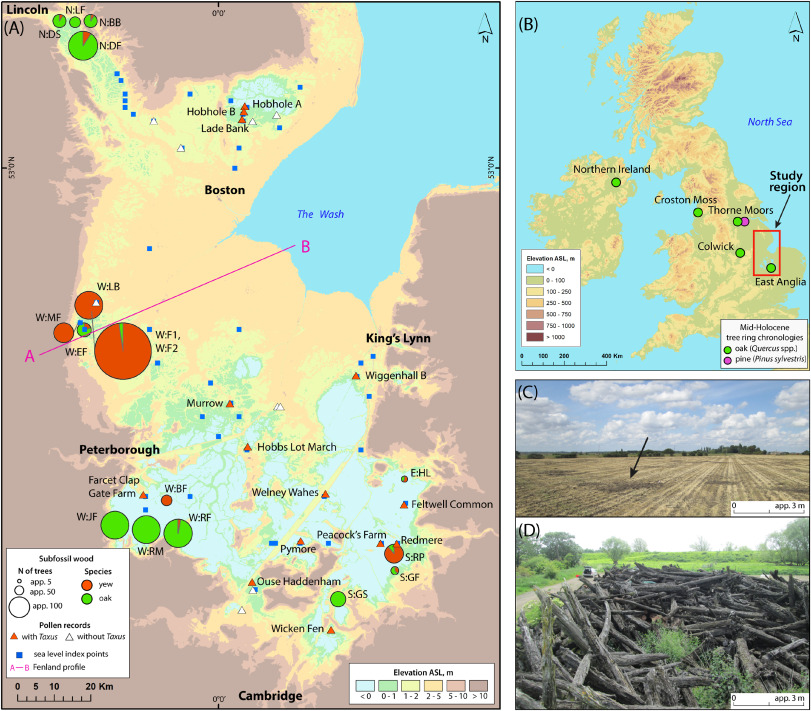Even an island like England had farming going back thousands of years. Hundreds of dead tree trunks in the low-lying Fens of eastern England, caught in the machinery of Fenland farmers while plowing their fields, were from yew trees that populated the area between four and five thousand years ago. Yet farmers did not cut them down, Fen yew woodlands died rapidly about 4,200 years ago due to climate change, when peat expanded the trees fell and were preserved until today. It is likely that a rapid sea level rise in the North Sea flooded the area with salt water.
Climate shifts have been common throughout history, and the same climate change that caused the rise in the North Sea may have caused a long-term, severe drought in the Middle East that may have been been a key cause for the collapse of ancient Egypt’s Old Kingdom and the Akkadian Empire in Mesopotamia.

(A) Topographical map of the Fenland with piles of subfossil wood visited in 2020–2023. Circle sizes correspond with pile size, and colours indicate tree species. Pollen records shown as triangles (white if no Taxus pollen were identified, and orange otherwise), and marine index points used for sea-level reconstructions shown as blue squares, after Waller (1994). The A-B line indicates the position of the profile shown in Fig.6. (B) Topographical map of the United Kingdom with the approximate locations of mid-Holocene TRW chronologies (Baillie and Brown, 1988; Boswijk and Whitehouse, 2002). (C) Agricultural field in the Fenland. Note the dark holes, from which subfossil trunks were excavated in August 2022. (D) Pile of subfossil yew trunks at site W:F1, at north of Peterborough. Credit: 10.1016/j.quascirev.2023.108414
Yet it was a net win. Today, the area is some of the most productive farmland in the UK, thanks to its rich peat soil, while yew (Taxus baccata), one of the longest-lived species in Europe, remain common across southern England. They're just gone from the Fens, the low-lying marshy region of eastern England, because those were unusable until drained between the 17th and 19th centuries using artificial drainage and flood protection.
Just like you can still stumble over bullets from the Civil War wandering southern US fields, old logs still pop up over time and get in farming equipment. This wood is often pulled up and piled at the edge of fields. Bad for farmers, but good for science.
Analysis by the Cambridge Tree-Ring Unit (TRU) showed that the yew trees dug up from Fenland fields were very old indeed: some of these ancient trees were 400 years old when they died. The new find provides unique climate information for over a millennium from around 5,200 years ago until about 4,200 years ago, when much of the Fens was a woodland of yew and oak: completely different than it looks today.
“Finding these very old trees in the Fens is completely unexpected – it would be like turning a corner in rural Cambridgeshire and seeing an Egyptian pyramid – you just wouldn’t expect it,” said Bebchuk. “It’s the same with nature – wood rots and decomposes easily, so you just don’t expect a tree that died five or four thousand years ago to last so long.”
Given that most of the Fens are barely above sea level, about 4,200 years ago, a sudden rise in sea level most likely killed the Fen woodlands. Apparently a global climate occurrence since other major events happened at the same time.






Comments